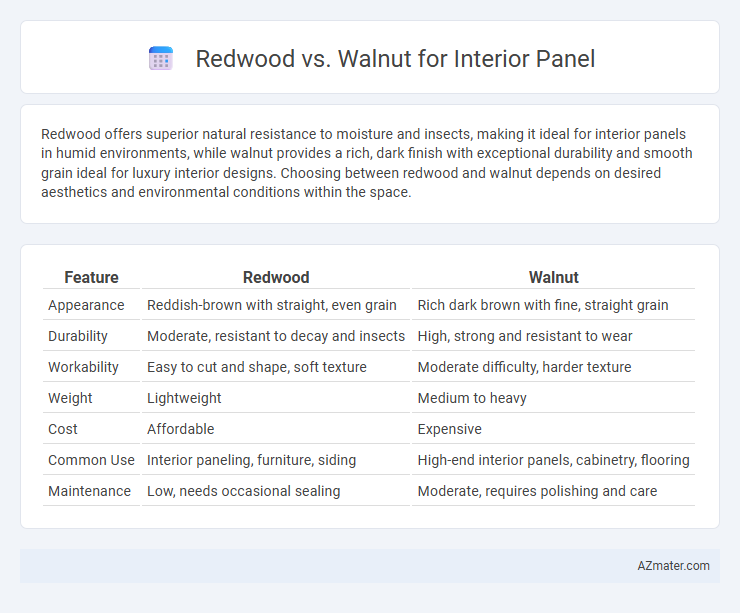Redwood offers superior natural resistance to moisture and insects, making it ideal for interior panels in humid environments, while walnut provides a rich, dark finish with exceptional durability and smooth grain ideal for luxury interior designs. Choosing between redwood and walnut depends on desired aesthetics and environmental conditions within the space.
Table of Comparison
| Feature | Redwood | Walnut |
|---|---|---|
| Appearance | Reddish-brown with straight, even grain | Rich dark brown with fine, straight grain |
| Durability | Moderate, resistant to decay and insects | High, strong and resistant to wear |
| Workability | Easy to cut and shape, soft texture | Moderate difficulty, harder texture |
| Weight | Lightweight | Medium to heavy |
| Cost | Affordable | Expensive |
| Common Use | Interior paneling, furniture, siding | High-end interior panels, cabinetry, flooring |
| Maintenance | Low, needs occasional sealing | Moderate, requires polishing and care |
Introduction to Redwood and Walnut Wood
Redwood offers a rich, reddish-brown hue with natural resistance to decay and insect damage, making it a popular choice for interior paneling in moisture-prone areas. Walnut is prized for its deep chocolate-brown color and fine, straight grain, providing a luxurious and durable surface ideal for upscale interior finishes. Both woods bring distinct aesthetic and functional qualities, with redwood excelling in natural durability and walnut favored for its elegant appearance.
Visual Appeal: Grain, Color, and Texture Comparison
Redwood interiors exhibit a rich reddish-brown color with a straight, tight grain that imparts a smooth, uniform texture ideal for contemporary paneling. Walnut features a deeper chocolate-brown to purplish hue with intricate, swirling grain patterns that add depth and luxurious warmth to any space. The choice between redwood's consistent elegance and walnut's dynamic visual complexity depends on the desired ambiance and design style for the interior.
Durability and Longevity: Redwood vs Walnut
Redwood offers superior resistance to decay and insect damage due to its high tannin content, making it highly durable for interior paneling in moist environments. Walnut, while prized for its rich color and fine grain, is softer and more susceptible to dents and scratches, impacting its long-term durability indoors. Choosing Redwood ensures extended longevity and lower maintenance, whereas Walnut requires careful handling to preserve its aesthetic appeal over time.
Workability and Ease of Installation
Redwood offers superior workability for interior paneling due to its lightweight nature and consistent grain, making it easier to cut, shape, and install compared to walnut. Walnut, while denser and harder, requires more effort and specialized tools for precise installation but provides exceptional durability and a rich, dark finish. Both woods offer unique advantages; redwood's ease of handling accelerates installation, whereas walnut's strength ensures long-term structural integrity.
Cost Differences Between Redwood and Walnut
Redwood interior panels typically cost less than walnut due to the faster growth rate and wider availability of redwood trees, making it a more budget-friendly option for large projects. Walnut, known for its rich color and durability, commands a higher price, influenced by its slower growth and limited supply. Choosing between redwood and walnut often depends on balancing cost constraints with desired aesthetic and performance qualities in interior paneling.
Environmental Impact and Sustainability
Redwood offers a lower environmental impact due to its faster growth rate and renewable sourcing from sustainably managed forests, reducing deforestation risks. Walnut, while prized for its rich grain and durability, often comes from slower-growing trees, leading to higher carbon footprints and less renewable availability. Choosing redwood for interior panels supports eco-friendly practices with better sustainability metrics and reduced ecological strain.
Maintenance and Care Requirements
Redwood interior panels require minimal maintenance due to their natural resistance to decay and insects, making them ideal for long-lasting applications. Walnut panels, while visually striking with their rich, dark tones, demand regular cleaning and occasional oiling to preserve their finish and prevent drying or cracking. Both woods benefit from controlled indoor humidity levels to maintain structural integrity and aesthetics over time.
Best Applications for Redwood Interior Panels
Redwood interior panels excel in environments requiring moisture resistance and natural decay protection, making them ideal for bathrooms, kitchens, and saunas. Their rich, warm tones and fine grain provide an aesthetically pleasing finish suitable for accent walls and ceilings in residential or commercial spaces. Redwood's lightweight and stability also make it preferable for intricate panel designs and custom millwork where ease of installation and long-term durability are essential.
Ideal Uses for Walnut Interior Panels
Walnut interior panels are ideal for high-end residential and commercial spaces due to their rich, dark brown color and natural grain patterns that add warmth and sophistication. They perform exceptionally well in areas requiring durability and resistance to wear, such as office walls, cabinetry, and accent panels. Walnut's stability and fine texture make it perfect for modern and traditional designs where elegance and longevity are essential.
Final Verdict: Which Wood Suits Your Interior Design?
Redwood offers a warm, reddish hue with natural resistance to decay and insects, making it ideal for rustic or nature-inspired interiors, while walnut provides a rich, dark brown shade with a smooth grain perfect for modern, elegant, or traditional designs. Walnut's durability and fine texture make it suitable for high-end, polished looks, whereas redwood excels in spaces requiring a more casual, cozy ambiance. Choosing between redwood and walnut depends on your desired aesthetic, budget, and interior use, with walnut favored for luxury and redwood preferred for warmth and organic charm.

Infographic: Redwood vs Walnut for Interior Panel
 azmater.com
azmater.com